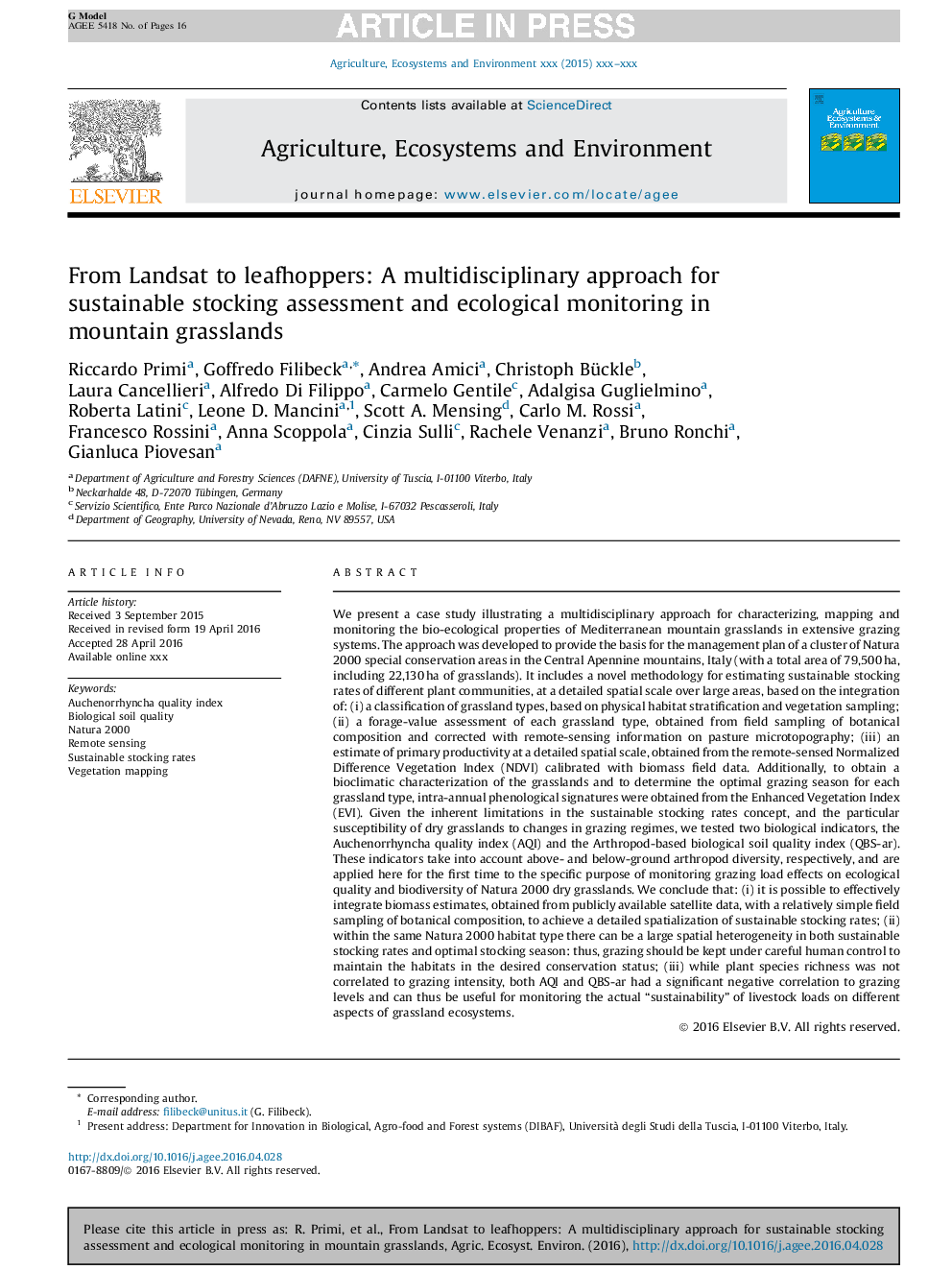| کد مقاله | کد نشریه | سال انتشار | مقاله انگلیسی | نسخه تمام متن |
|---|---|---|---|---|
| 5538129 | 1552018 | 2016 | 16 صفحه PDF | دانلود رایگان |
عنوان انگلیسی مقاله ISI
From Landsat to leafhoppers: A multidisciplinary approach for sustainable stocking assessment and ecological monitoring in mountain grasslands
ترجمه فارسی عنوان
از لندست به لپ تاپ ها: یک رویکرد چند رشته ای برای ارزیابی پایداری انبوه و نظارت بر محیط زیست در مراتع کوهستانی
دانلود مقاله + سفارش ترجمه
دانلود مقاله ISI انگلیسی
رایگان برای ایرانیان
کلمات کلیدی
موضوعات مرتبط
علوم زیستی و بیوفناوری
علوم کشاورزی و بیولوژیک
علوم زراعت و اصلاح نباتات
چکیده انگلیسی
We present a case study illustrating a multidisciplinary approach for characterizing, mapping and monitoring the bio-ecological properties of Mediterranean mountain grasslands in extensive grazing systems. The approach was developed to provide the basis for the management plan of a cluster of Natura 2000 special conservation areas in the Central Apennine mountains, Italy (with a total area of 79,500Â ha, including 22,130Â ha of grasslands). It includes a novel methodology for estimating sustainable stocking rates of different plant communities, at a detailed spatial scale over large areas, based on the integration of: (i) a classification of grassland types, based on physical habitat stratification and vegetation sampling; (ii) a forage-value assessment of each grassland type, obtained from field sampling of botanical composition and corrected with remote-sensing information on pasture microtopography; (iii) an estimate of primary productivity at a detailed spatial scale, obtained from the remote-sensed Normalized Difference Vegetation Index (NDVI) calibrated with biomass field data. Additionally, to obtain a bioclimatic characterization of the grasslands and to determine the optimal grazing season for each grassland type, intra-annual phenological signatures were obtained from the Enhanced Vegetation Index (EVI). Given the inherent limitations in the sustainable stocking rates concept, and the particular susceptibility of dry grasslands to changes in grazing regimes, we tested two biological indicators, the Auchenorrhyncha quality index (AQI) and the Arthropod-based biological soil quality index (QBS-ar). These indicators take into account above- and below-ground arthropod diversity, respectively, and are applied here for the first time to the specific purpose of monitoring grazing load effects on ecological quality and biodiversity of Natura 2000 dry grasslands. We conclude that: (i) it is possible to effectively integrate biomass estimates, obtained from publicly available satellite data, with a relatively simple field sampling of botanical composition, to achieve a detailed spatialization of sustainable stocking rates; (ii) within the same Natura 2000 habitat type there can be a large spatial heterogeneity in both sustainable stocking rates and optimal stocking season: thus, grazing should be kept under careful human control to maintain the habitats in the desired conservation status; (iii) while plant species richness was not correlated to grazing intensity, both AQI and QBS-ar had a significant negative correlation to grazing levels and can thus be useful for monitoring the actual “sustainability” of livestock loads on different aspects of grassland ecosystems.
ناشر
Database: Elsevier - ScienceDirect (ساینس دایرکت)
Journal: Agriculture, Ecosystems & Environment - Volume 234, 16 October 2016, Pages 118-133
Journal: Agriculture, Ecosystems & Environment - Volume 234, 16 October 2016, Pages 118-133
نویسندگان
Riccardo Primi, Goffredo Filibeck, Andrea Amici, Christoph Bückle, Laura Cancellieri, Alfredo Di Filippo, Carmelo Gentile, Adalgisa Guglielmino, Roberta Latini, Leone D. Mancini, Scott A. Mensing, Carlo M. Rossi, Francesco Rossini, Anna Scoppola,
